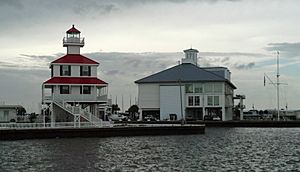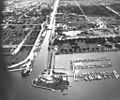New Basin Canal facts for kids
The New Basin Canal, also known as the New Canal, was a shipping canal in New Orleans, Louisiana. It was used for boats and trade from the 1830s until the 1940s.
Contents
Building the New Basin Canal
The idea for the New Basin Canal came from a company called the New Orleans Canal and Banking Company. They started in 1831 with a lot of money, about 4 million US dollars. Their goal was to build a new shipping canal. This canal would go from Lake Pontchartrain through swampy land to the busy "American" part of New Orleans. It was meant to compete with an older canal called the Carondelet Canal.
Work on the canal began in 1832. Building a canal through a swamp was very hard and dangerous. Many workers got sick with Yellow fever, a serious illness spread by mosquitoes. Because of this, the company decided not to use enslaved people for the work, as losing them was too costly.
Irish Workers and Their Sacrifices
Instead, most of the work was done by Irish immigrants. These workers had just arrived in New Orleans, often looking for any job they could find. They were willing to risk their lives for about $1 a day, which was a lot of money for them at the time.
Sadly, many Irish workers died while building the canal. They faced tough conditions, diseases like yellow fever, and hard physical labor. No one kept an exact count of how many died, but estimates range from 8,000 to 20,000 people. Many were buried without any grave markers right next to the canal in the dirt used to build the roads and levees.
When Was the Canal Finished?
By 1838, after spending about $1 million, the canal was mostly finished. It was about 60 feet (18 meters) wide and 3.17 miles (5.1 kilometers) long. Small boats could use it, and they were charged about 37.5 cents per ton of goods they carried. Over the next ten years, the canal was made even bigger. It became 12 feet (3.7 meters) deep and 100 feet (30 meters) wide, with shell roads built alongside it.
Where Was the New Basin Canal Located?
The canal originally connected to Lake Pontchartrain near where Robert E. Lee and West End Boulevards are today. Later, stone walls called jetties were added, making the canal reach further into the lake. The New Canal Lighthouse was built at the very end of one of these jetties, marking the entrance to the canal.
From the lake, the canal went south through the swamp. It then cut through a higher area called Metairie Ridge, passed through the lowlands of the mid-city, and finally ended in a turning basin. This basin was located in what is now the New Orleans Central Business District, near Rampart Street and Howard Avenue.
How Was the Canal Used?
The New Basin Canal was very important for trade and business throughout the 1800s. It also helped drain water from nearby areas, which was useful in a city built on low, wet land. People also used the canal to bring bald cypress trees into the city. These trees were cut down in what is now the Lakeview neighborhood and floated down the canal. They were then used to build many houses in the uptown area of New Orleans.
What Happened to the Canal?
After World War I, the canal became less important. This was especially true after the Industrial Canal opened in 1923, providing a new, modern shipping route.
In 1936, the state of Louisiana decided to close the canal. By 1937-1938, a large part of the canal, back to Claiborne Avenue, was filled in with dirt. However, a smaller part of the canal kept working until after World War II. By around 1950, most of the canal was filled in.
The Canal Today
Today, only about a half-mile-long stretch of the canal remains at the lakefront, near the lighthouse. This part is now used as a harbor for small boats and yachts.
Much of the original canal route was turned into the Pontchartrain Expressway in the 1950s. This highway later became part of I-10. The area from the highway to just before Robert E. Lee Boulevard was developed into the New Basin Canal Park. This is a long, green park that runs next to West End Boulevard.
On November 4, 1990, a large Celtic cross made of marble was placed in the park. It was put there by the Irish Cultural Society of New Orleans to remember the Irish workers who built the canal.
The New Canal Lighthouse
The New Canal Lighthouse, which stands at the entrance to the canal, is a historic building. It was added to the National Register of Historic Places in 1985.
Damage and Repair
In 2005, the lighthouse was badly damaged by Hurricanes Katrina and Rita. Its first floor collapsed, and its top part, called the cupola, fell off.
In 2006, a group called the Lake Pontchartrain Basin Foundation took over the lighthouse. They signed an agreement with the United States Coast Guard to fix it. The lighthouse was carefully taken apart, and its pieces were stored away. Reconstruction began in February 2012 and was finished in 2013, bringing the lighthouse back to its original look.
Images for kids






